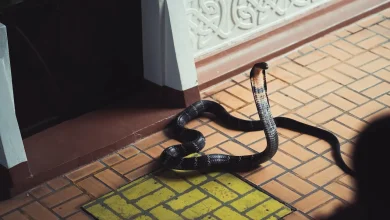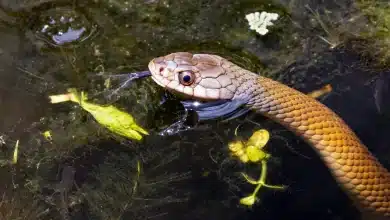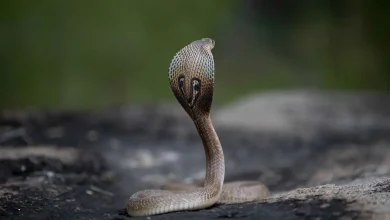Spitting Cobras
Spitting Cobras Information
Spitting cobras are fascinating venomous snakes that have the ability to spray dangerous venom into the eyes of attackers in self-defense so they can get away. Scary, right?
Introduction
Spraying venom through the air is a defense mechanism to give the spitting cobra some time to get away. The venom is caustic to the eyes and other mucous membranes and can cause blindness if left untreated.
Let’s learn a lot more about this wonderful snake of the Reptile class, the Spitting Cobras!
What Is a Spitting Cobra?
Spitting cobras are a group of snakes in Africa and Asia in the Naja genus that can forcefully expel venom through two fangs in the front of their upper jaw, spraying it into the air and the eyes of predators. Like other venomous front-fanged snakes, they are also capable of delivering venomous bites if they get close enough to their prey or something they feel threatened by.
African Spitting Cobras
- Naja ashei: Ashe’s spitting cobra
- Naja katiensis: Katanga cobra
- Naja mossambica: Mozambique spitting cobra
- Naja nigricincta: Black-necked spitting cobra
- Naja nigricincta woodi: Wood’s spitting cobra
- Naja nigricollis: Black-necked cobra
- Naja nubiae: Nubian cobra
- Naja pallida: Pale forest cobra
Asian Spitting Cobras
- Naja atra *: Black cobra
- Naja kaouthia * (range includes Thailand): Monocled cobra
- Naja sagittifera *: Banded spitting cobra
- Naja mandalayensis: Mandalay cobra
- Naja philippinensis: Philippine cobra
- Naja samarensis: Samar cobra
- Naja siamensis: Siamese or Black-and-white spitting cobra
- Naja sputatrix: Asian spitting cobra
- Naja sumatrana (range includes Thailand): Sumatran spitting cobra
* Note – N. Atra, N. kaouthia, and N. sagittifera
These three snakes are not known to consistently spray venom as the other spitters, but certain snakes of their species can spit venom a short distance, or occasionally a meter (39 inches) or more.
Staff working in snake shows in Thailand and other countries have reported being sprayed in the eyes with venom occasionally from N. kaouthia. In speaking with one renowned Thailand biologist, I was told that there are areas of the country where N. kaouthia can rather consistently spit venom. In other areas of the country, we don’t hear of this ability.
On a personal note, I know four people who have been sprayed in the eyes by spitting cobras. Three of them were working in a snake show, and the other had found a spitting cobra in the forest and didn’t realize it could spit the venom so far.
So, it’s interesting and we can learn something. When you come upon any cobra and it hoods, or you notice it, cover your eyes immediately and back away to avoid getting sprayed in the face.
Spitting Snakes in Other Families
There are no spitting cobras outside of the Elapidae family, but there is one in a different genus than the others.
There is one snake different from the other spitting cobras, H. Haemachatus. Hemachatus haemachatus (Ring-necked spitting cobra) is found in Africa and this snake doesn’t share the Naja genus, but it is capable of hooding up like a true cobra and spitting venom. If the venom doesn’t hit the target, the snake will play dead.
Where Do Spitting Cobras Live?
Spitting cobras can be found in Africa and many countries in Asia including Thailand, Burma, Philippines, Laos, Cambodia, Indonesia, Malaysia, India, Sri Lanka, China, and Taiwan.
In Southeast Asia, the Siamese and Equatorial Spitting Cobras tend to live in forests and away from people when possible. They don’t tend to share the same habitat with Naja kaouthia, which doesn’t mind at all living around humans.
What Are the Different Types of Spitting Cobras?
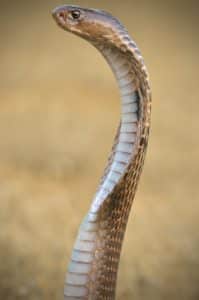
All of them are different types because they are different specific species. We could separate them into groups based on where they live: Africa vs Asia. We could group them into different lengths or venom toxicity (LD-50 records), true spitters vs not, or some other criteria.
Physical Characteristics
Size and appearance
Most of the spitting cobras listed are around the 1-meter (3.3 feet) length as adults, but some of them can reach 2 meters or longer. The largest is Ashe’s spitting cobra (Naja ashei). It is native to East Africa and can grow up to 2.7 meters (8.9 feet) long. The average length of an adult Ashe’s spitting cobra is 1.3 to 2 meters (4.3 to 6.6 feet).
In Thailand, we haven’t seen one over 2 meters in length and most are just over 1 meter.
Venom
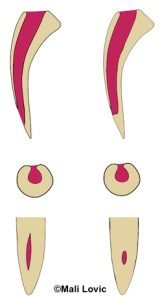
Spitting cobra venom/toxungen is cytotoxic and neurotoxic. If sprayed into the eyes and left untreated chemosis and corneal swelling can result. Blindness can follow. Spitting cobras are capable of inflicting deadly bites to humans as their venom is very strong and primarily neurotoxic, acting on essential muscles like the diaphragm and heart.
Senses
Snakes have five main senses: sight, hearing, smell, taste, and touch.
Snakes have good vision, especially at night. They have a pair of large eyes that are located on the sides of their head, which gives them a wide field of view. Snakes can also see infrared light, which allows them to see heat signatures.
Snakes do not have external ears, but they have a good sense of hearing. They can hear sounds in a range of frequencies that is similar to humans. Snakes can also hear vibrations, which they use to detect prey and predators.
Snakes have a very good sense of smell. They have a pair of forked tongues that they use to collect scent particles from the air. The tongue is then transferred to a special organ in the roof of the snake’s mouth called the Jacobson’s organ. The Jacobson’s organ analyzes the scent particles and helps the snake to identify prey and predators.
Snakes do not have a very good sense of taste. They have taste buds on their tongues, but they are not as sensitive as the taste buds of humans. Snakes mostly rely on their sense of smell to find food.
Snakes have a very good sense of touch. They have receptors all over their bodies that allow them to feel vibrations, pressure, and temperature. Snakes use their sense of touch to detect prey, predators, and obstacles.
Behavior
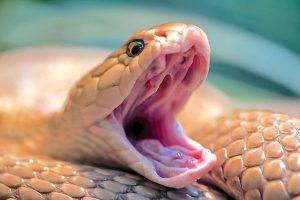
Snakes are only concerned with survival and reproduction, and the latter takes place once per year. Most of a cobra’s life is spent hunting prey like rats and other rodents, chickens and other eggs, lizards, frogs, and other snakes.
Though known for being ground-dwelling snakes, spitting cobras can also be found in trees and bushes. In Southern Thailand, they have been seen sunning themselves in the morning sun to wake up. They are, of course, ectothermic and need the heat of their surroundings to raise their body temperature.
Spitting cobras in Asia prefer dense forests and aren’t found in human-inhabited areas often. There are fewer bites from them vs other cobras, and they are seldom seen, even when trying specifically to find them.
Hunting
Cobras are rather active when hunting in comparison to many other snakes who are largely inactive and waiting for prey to come close enough to strike. In the hot afternoon sun, some cobras become very active and go looking for prey. This is when we see them crossing the roads a lot in Krabi and other Thailand provinces.
Mating
Mating takes place once per year and is dependent on the temperatures of the area the spitting cobras live in. In Southern Thailand, we see hatchling monocled cobras around October/November months.
Cobras are egg layers (oviparous).
Defense
These cobras will hood and some will hiss before, and often during striking or spraying venom through their fangs. A last resort is a bite. Some cobras can move very fast and in unpredictable ways as they try to get close enough to strike someone harassing them.
Interactions with Humans
Unfortunately, some cobras share habitat with humans and often end up in yards, homes, and businesses. In these cases, the snakes are almost always looking for prey they smell like rodents or eggs, usually from a chicken coop.
Dangers of Spitting Cobras
How To Avoid Being Bitten by a Spitting Cobra
Here are some tips for avoiding being bitten by a spitting cobra.
- Be aware of your surroundings and avoid areas where spitting cobras are known to live.
- Wear shoes and long pants when you are in areas where spitting cobras are present.
- Do not disturb any snakes that you see.
- If you see a spitting cobra, do not approach it. Back away slowly and calmly and cover your eyes just in case, it is very hard to judge when they will spit venom.
Treatment for Spitting Cobra Bites
All of our recommendations on the treatment of venomous snakebites come from the University of Adelaide’s (Australia) Toxinology.com website. Follow this link to see a page on Naja Siamensis and scroll down to the “First Aid” section for specific instructions on treating spitting cobra bites from this snake.
Treatment recommendations may be slightly different for each snake species. Use the Snake search feature in the top left of the website to find other venomous snakes in your area. Search by country for the best results.
Treatment for Spitting Cobra Venom in Eyes
If venom has contacted your eyes, immediately rinse with whatever liquid you have available and that includes soda, urine, or whatever you can get quickly. A long 10-20 minute flush of the eyes is necessary to remove all venom, and even then you should be on the way to the hospital for a proper eye wash as soon as possible.
As I mentioned, I’ve seen four people with spitting cobra venom in their eyes and they all were fine after immediate and extensive eye-washing and a hospital visit.
Spitting Cobra Conservation Status
Some spitting cobras have populations on the decline. The following are listed at IUCNRedlist.org as declining and most listed as VU – vulnerable.
Spitting Cobras with Decreasing Populations
Endangered Population of Spitting Cobras
- Naja sagittifera
FAQ
Can monocled cobras spit venom?
Yes, many can leak or spit venom from a few inches to a meter or more. Do be careful with every cobra you find and be prepared for the quick spray of venom. Most people don’t expect it.
How far can spitting cobras spray venom?
Without wind at its back, a spitting cobra can spray venom in a mist or stream or some combination as far as 3 meters away. With wind, the distance can be twice that or more. Typically spitting cobras don’t spray venom unless the target is within 3 meters or so.
How fast can spitting cobras kill a person with a bite?
For a normal-sized adult, you probably have hours before the effects of the venom reach a critical point. For children, death and serious complications can result sooner due to lower body weight. In all cases, even if you suspect a dry bite, you should go immediately to the hospital.
Remember, not all spitting cobra venom is the same and some of the spitters on the list above can kill you within 30 minutes. Pay particular attention and be careful with the Philippines Spitting Cobra, and remember that there are other cobras like the Caspian cobra that is known to have caused fatalities within 30 minutes of a bite.
Conclusion
- Spitting cobras can spray venom 5 meters and more with the wind. Rinse immediately AND go to the hospital.
- Some spitting cobras have primarily neurotoxic venom, but also cytotoxic properties. Significant necrosis can take place after a bite.
- Shield your eyes immediately if you see a hooded cobra.
- Spitting cobras are only in Africa and Asia. They are not in Australia, USA, Canada, Mexico, Europe, or anywhere else!
Resources
- Here’s a page from the University of Adelaide’s Toxinology website showing a list of cobras, their species, and where they are found. Click on each species to see more info.
- IUCN Redlist – Here’s a page of snakes in the Naja genus.
[Photo Credits are in the captions area. If not captioned, photos are used with permission from sites offering royalty-free images.]


